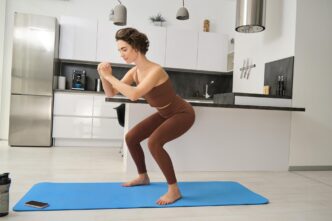A Quick Takeaway
The Story Behind the Trend
How to Make It Work for You
The Community View
Unlocking full-body strength doesn’t require a gym full of bulky equipment; in fact, all you need are a few dumbbells and the right approach. This comprehensive guide is designed for anyone, from beginners to seasoned lifters, looking to build functional strength, increase muscle mass, and improve overall fitness efficiently and effectively, right from the comfort of their home or a compact gym space. We will explore the unparalleled benefits of dumbbell training, outline core principles for success, and provide a meticulously crafted full-body workout routine to help you achieve remarkable results.
Why Dumbbells Are a Game-Changer
Dumbbells offer a unique blend of versatility, accessibility, and effectiveness that few other pieces of equipment can match. Their independent movement allows for unilateral training, addressing muscle imbalances and enhancing stability often overlooked by fixed machines. This freedom of motion also engages more stabilizer muscles, translating to better functional strength for everyday activities.
Moreover, dumbbells are incredibly space-efficient and cost-effective, making them an ideal choice for home gyms. They are also highly portable, enabling you to maintain your fitness routine wherever life takes you. From pressing and pulling to squatting and hinging, dumbbells can target every major muscle group with a wide array of exercises.
The Principles of Effective Dumbbell Training
To maximize your gains and minimize injury risk, it’s crucial to adhere to fundamental training principles. These guidelines ensure your efforts are productive and sustainable over the long term, fostering continuous progress.
Progressive Overload
The cornerstone of strength and muscle growth, progressive overload means consistently challenging your muscles more over time. This can be achieved by increasing the weight, performing more repetitions, adding more sets, reducing rest periods, or improving exercise form. Without progressive overload, your body has no reason to adapt and grow stronger.
Proper Form
Executing each exercise with impeccable form is paramount for two reasons: preventing injury and effectively targeting the intended muscles. Always prioritize controlled movements over lifting heavy weights. If your form breaks down, it’s a clear sign to reduce the weight or take a brief rest.
Mind-Muscle Connection
Actively focusing on the muscle you are working during each repetition significantly enhances its activation. This conscious effort helps you feel the muscle contract and stretch, leading to more effective training and better results. It transforms your workout from just moving weights into a deliberate act of muscle building.
Your Ultimate Full-Body Dumbbell Workout
This routine is designed to hit all major muscle groups, promoting balanced strength and development. Aim to perform this workout 2-3 times per week, allowing at least one day of rest between sessions for optimal recovery and muscle repair.
Warm-Up (5-10 minutes)
Begin every session with a dynamic warm-up to prepare your body for the workout ahead. This increases blood flow to your muscles, improves joint mobility, and reduces the risk of injury. Include exercises like arm circles, leg swings, torso twists, and light cardio such as jumping jacks or marching in place.
The Workout
Perform 3 sets of 8-12 repetitions for each exercise, resting 60-90 seconds between sets. Choose a weight that allows you to complete the repetitions with good form, feeling challenged by the last few reps.
Lower Body
- Goblet Squat: Hold one dumbbell vertically against your chest with both hands. Stand with feet shoulder-width apart, toes slightly out. Squat down as if sitting in a chair, keeping your chest up and core engaged.
- Dumbbell Romanian Deadlift (RDL): Hold a dumbbell in each hand, palms facing your thighs. Keeping a slight bend in your knees and a straight back, hinge at your hips, lowering the dumbbells towards the floor. Feel the stretch in your hamstrings before returning to the starting position.
- Dumbbell Reverse Lunges: Hold a dumbbell in each hand. Step back with one leg, lowering your hips until both knees are bent at approximately 90-degree angles. Push off your back foot to return to the start. Alternate legs.
Upper Body – Push
- Dumbbell Bench Press: Lie on a flat bench or the floor, holding a dumbbell in each hand above your chest, palms facing each other or forward. Lower the dumbbells slowly to the sides of your chest, then push them back up.
- Dumbbell Overhead Press: Sit or stand with a dumbbell in each hand at shoulder height, palms facing forward. Press the dumbbells directly overhead until your arms are fully extended, then slowly lower them back down.
Upper Body – Pull
- Dumbbell Bent-Over Rows: Hinge at your hips, keeping your back straight and knees slightly bent. Let the dumbbells hang towards the floor. Pull the dumbbells up towards your chest, squeezing your shoulder blades together.
- Single-Arm Dumbbell Row: Place one hand and knee on a bench for support. Let the other arm hang straight down with a dumbbell. Pull the dumbbell up towards your chest, keeping your elbow close to your body.
Core & Arms
- Dumbbell Farmer’s Carry: Hold a heavy dumbbell in each hand, standing tall with shoulders back and core tight. Walk for a designated distance or time, focusing on maintaining good posture.
- Dumbbell Bicep Curls: Stand tall with a dumbbell in each hand, palms facing forward. Keeping your elbows tucked, curl the dumbbells up towards your shoulders.
- Dumbbell Triceps Extensions (Overhead): Hold one dumbbell with both hands, extending it overhead. Keeping your elbows pointed forward, lower the dumbbell behind your head by bending your elbows, then extend back up.
Cool-Down (5-10 minutes)
Conclude your workout with a cool-down involving static stretches to improve flexibility and aid recovery. Hold each stretch for 20-30 seconds, focusing on the muscles you’ve just worked. Examples include hamstring stretches, quad stretches, chest stretches, and triceps stretches.
Crafting Your Workout Schedule
Consistency is more important than intensity when starting. Aim for 2-3 full-body dumbbell workouts per week, ensuring you have at least one rest day between sessions. This allows your muscles ample time to recover and grow stronger. As you advance, you can adjust the frequency or volume to match your body’s recovery capacity.
Scaling for All Levels
This workout is adaptable for everyone. Beginners should start with lighter weights, focusing intently on mastering form before increasing the load. Advanced lifters can challenge themselves by using heavier dumbbells, increasing reps or sets, shortening rest times, or incorporating more complex variations of the exercises.
Embrace Your Strength Journey
A full-body dumbbell workout is an incredibly effective and accessible way to build strength, improve physique, and enhance overall health. By committing to consistent effort, prioritizing proper form, and embracing progressive overload, you will unlock your full strength potential. Remember that dedication and patience are key, and every rep brings you closer to a stronger, more resilient you.








